The transition to working dogs
Host: Annaburroo Station
Written by Barb Phillips – Manager, Annaburroo Station.
It was in 2013 after attending a Neil McDonald Advanced Livestock Management school that I decided to lift my game and invest some time into our working dogs.
We were based in Katherine and had a handful of beautifully bred kelpies and collies. Unfortunately due to my ignorance and Adrian’s great frustration they used to do a fair bit of ‘gold coasting’ (a term used to describe dogs that are let out to run about with very little control on them). This generally occurred because I thought it was unfair for them to be locked up in their cages when not at work.
Neil had made it clear to me that the collie I had brought to the school could be ‘saved’ but it was best that I get to it right away. ‘Saving’ the collie meant consistent controlled contact with that dog and putting it away before diverting to feeding chooks and so forth!
So, much to Adrian’s delight, I finally understood why he was bashing his head against the wall trying to explain to the city girl that “they are work dogs, Barb!”
Working dogs have been selected and bred according to type, ability, and environmental adaptation. There is great variance within breeds and litters. Some dogs may work particular areas around the mob better than others, some can do the lot. One dog may have presence and their position may cause a change in the structure of the mob while other dogs need to do a whole lot of running and barking in frustration when the cattle are not reacting to their efforts.
This natural ability that is bred in the dog needs to be harnessed and in order to achieve this the dog must be controlled. You may have seen working dogs chasing butterflies around the paddock or trapping a lizard amongst the rocks, all the while transfixed in concentration on the job at hand. These dogs need jobs to do and love working livestock, listening for your voice directing or praising them, waiting for the call to ‘go hop up’ or ‘sit’.
So as time went by we decided to put together a team of dogs. We had started at Annaburroo Station by then and could see what a tremendous asset dogs would be to us.
After much persuasion I dragged Adrian along to another Neil McDonald school. He needed to know what wavelength I was coming from even if he had used working dogs prior to my arrival. To his credit, he went the extra mile for me and attended the school.
The school was very good. We brought along our latest additions, ‘Ninja’ from Reg Underwood and ‘Lisa’ from Trudi Oxley. In fact ‘Lisa’ had shaped up so nicely we contacted Trish Cowley and bought his mother ‘Roxie’ who joined Adrian’s team the moment I started using her!
As per usual, the last day of any dog school always lead to some dog trading going on amongst attendees. Of course we got right into it and added ‘Stripper’, ‘Monkey’, ‘Doc’, and ‘Pistol’ to the team. We managed to fit the ever increasing dog team on the ute for the trip home and set to work transforming the cattle at Annaburroo.
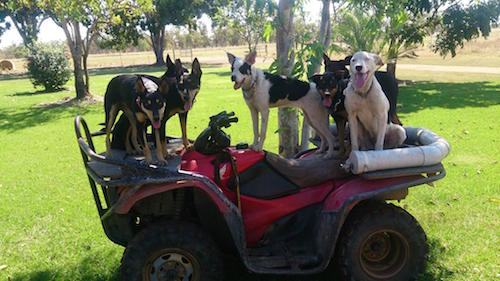 ‘Thorn’, ‘Roxie’, ‘Stripper’, ‘Shadow’, ‘Doc’, ‘Monkey’, and ‘Ninja’.
‘Thorn’, ‘Roxie’, ‘Stripper’, ‘Shadow’, ‘Doc’, ‘Monkey’, and ‘Ninja’.
The entire herd at Annaburroo was introduced to dogs last season. They have been exposed to helicopters, vehicles, bikes, horses, and dogs. They have been taught to walk in a mob, to block up, to lead out behind a horse or bike, and respect the space between them and the leader. In fact, one of the most important jobs the dogs have had was to teach the cattle to block. They had no respect whatsoever and would plough straight over you in the yard or whilst being walked out. Some cows took three days of dog work until they were ready to walk down the laneway and back out to their paddock.
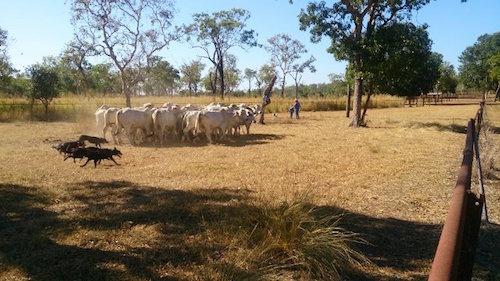 Weaners in a holding paddock.
Weaners in a holding paddock.
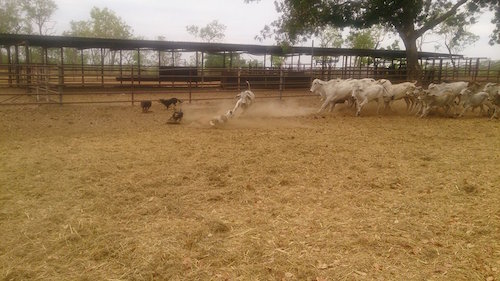 Blocking the cattle as they are let out from the top yard.
Blocking the cattle as they are let out from the top yard.
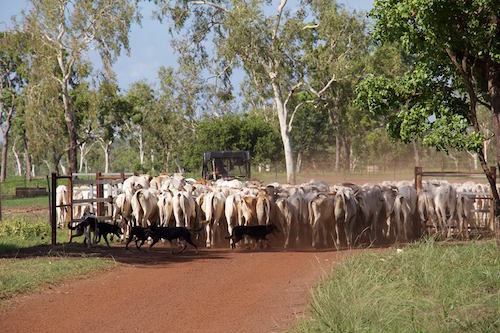 The mob walking behind the buggy.
The mob walking behind the buggy.
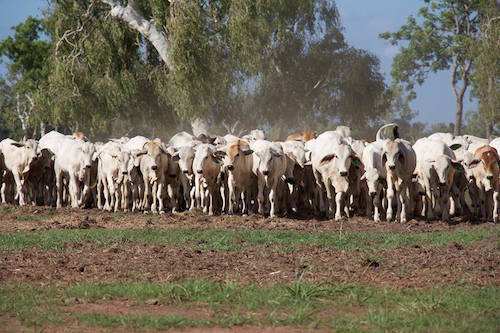 Respecting the person at the lead.
Respecting the person at the lead.
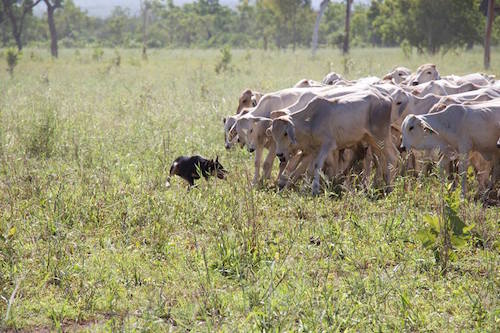 Adrian’s pup ‘Thorn’ at work.
Adrian’s pup ‘Thorn’ at work.
Kelvin ‘Twisty’ Barr visited us last year and ran a hands-on dog school at Annaburroo. Twisty represented South Australia in dog trials for 20 years and is very good at creating a relaxed environment in which to work the dogs. He has helped us a lot.
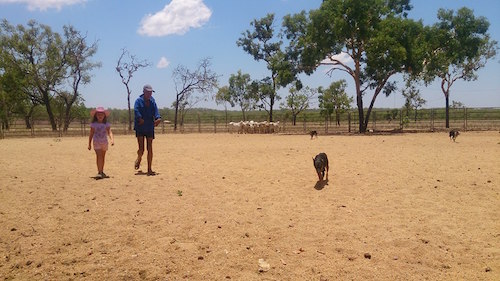 Twisty helping Jess to work her dog ‘Lisa’.
Twisty helping Jess to work her dog ‘Lisa’.
The beauty of dogs is that we can take them anywhere with us on the back of the buggy. The fences at Annaburroo were atrocious when we arrived in 2015 and we have spent many days pulling up full panels of pickets and wire that were buried under grass and debris and fixing broken wires. The majority of paddocks are now sound but the cattle have learnt to push at fences and pick their way through the wires.
The cattle that have shown these ‘fence crawling tendencies’ have been held in sale paddocks and so before the rain set in the cattle were continually getting out through fences chasing green pick. The dogs loved it as they were often on the back of the buggy on their way to deal with yet another mob that needed to be walked along and put back through the gate.
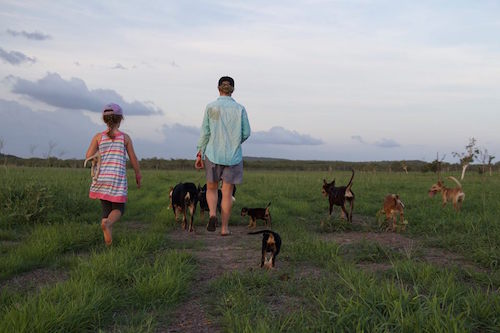 Taking the dogs for their evening walk.
Taking the dogs for their evening walk.
We now have 17 dogs between us and find this to be a good number allowing us to spell some while others are working. Would we let any of them go? I doubt it very much. They just get better each time they work and they really are a part of our family.
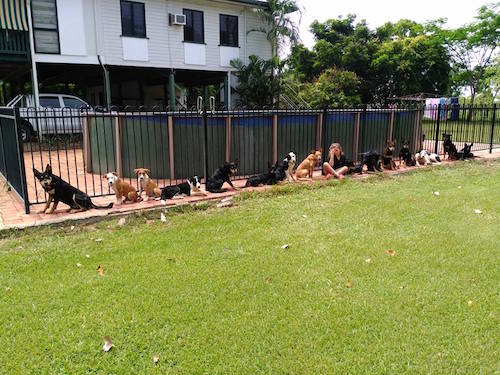 The team.
The team.
